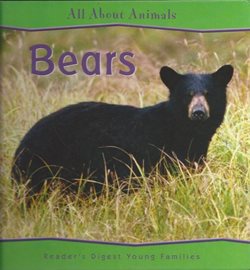This month’s Book Nook topic is...
Introducing Rare Vocabulary with All About Animals: Bears


Children learn new words every day. How many words they learn and how well they understand and use these words will have a significant impact on the kinds of readers they eventually become. As children enter school, they will encounter more sophisticated vocabulary. In this Book Nook, I’ll share some helpful tips for how to introduce rare vocabulary words and build children’s understanding of them.
Let’s get started!
- The Book:
-
All About Animals: Bears by Catherine Lukas (Reader’s Digest Young Families)
- Why we picked it:
-
Most children are interested in animals and are familiar with bears, so I chose a non-fiction book that would complement what children already know, while sparking their curiosity for learning something new. The pages of this book are filled with large captivating photographs of bears in the wild, and there are rare or uncommon words on almost every page, like “carnivore”, “hibernation” and “habitat”.
- The third time you read the book
-
Now that you’ve made the connection between pictures and print, this time, you might POP to show how numbers have meaning throughout the book. In Scaredy Squirrel’s daily routine, illustrations of clocks are shown with the digital time written underneath. You could say, “These are numbers that tell us the time on the clock. These numbers say that it’s 7:00 am. That’s morning time. It’s time for Scaredy Squirrel to eat his nuts.” This will help your child understand that print doesn’t just represent words, but it can also represent time.
- Why introduce rare vocabulary?
-
Having a larger vocabulary makes it easier to understand what is being read. Vocabulary is also a tool for thinking and learning about the work and is directly linked to academic achievement. But just exposing children to new words is not enough. We must take the time to explain those words to deepen children's understanding of them.
- Picking up appropriate words
-
Selecting the “right” vocabulary means going beyond everyday words and including more sophisticated words. Non-fiction books are a great tool for introducing rare vocabulary because they often contain specialized, topic-specific words that we don’t use every day. Also, we can usually use the context of the book to help explain new words.
- Shoot for the SSTaRS
-
At The Hanen Centre, we talk about making new words “sparkle”, or stand out, by using a strategy called “Shoot for the SSTaRS”. It’s an acronym that stands for: Stress, Show, Tell and Relate, and Say it again. Let’s shoot for the SSTaRS with “hibernation.”
Stress
Make hibernation stick out from the other words by saying it louder and slower than the rest of the text. You can also pause before and after saying the word.
Show
You can show what a word means in a variety of ways – the easiest of which is using the illustrations in the book. For example, you can show hibernation by pointing to the picture of the bear sleeping.
Tell
Give the child a short definition of the word hibernation. You could say, “hibernation means that the bear is going into a deep sleep all winter.” Or, tell the child what is not hibernation: “Animals that we see outside in the winter time are not in hibernation.”
and Relate
Relating the new word to other concepts or experiences is extremely important. This will help the child associate the word with other situations and will make the word much more relevant to him. Relate this word to other experiences by saying “Remember when we saw the chipmunk collecting all of those nuts in September? He was preparing for hibernation.”
Say it again...!
This is another essential step to consolidate the child’s learning: repeat the word both by re-reading the book, and by saying the word again in other situations. For example, if you see a bear on television who looks skinny, you could say, “That bear looks like he just came out of hibernation and hasn’t had anything to eat all winter. He must be so hungry!”
Bears is a book that lends itself very well to being re-read because there are so many rare words and interesting facts about bears. Use this to your advantage and shoot for the SSTaRS with hibernation and other rare words every time you read.
- The first time you read this book
-
Introduce new vocabulary words by Stressing, Showing, and Telling the words. Try to keep your explanations short so that you don’t interrupt the flow of the book.
- The second time you read this book
-
Continue to emphasize the vocabulary that you introduced the first time you read the book, only this time, offer more explanation about the concept of hibernation. You can also use the second reading to relate this word to the child’s knowledge and past experiences.
- The third time you read this book
-
To deepen your child’s understanding of hibernation you could act out a scenario where you pretend to be animals who are preparing for a long winter of hibernation. At this point, you could also start introducing other rare vocabulary words.
Try to make a point of using the new word during everyday conversations – this will help your child start to use the word himself when the opportunity presents itself. You may be surprised to hear your child use the rare vocabulary word on his own, when you least expect it!
Happy reading!
We’ll let you know when a new Book Nook topic
has been posted!
Return to Book Nook